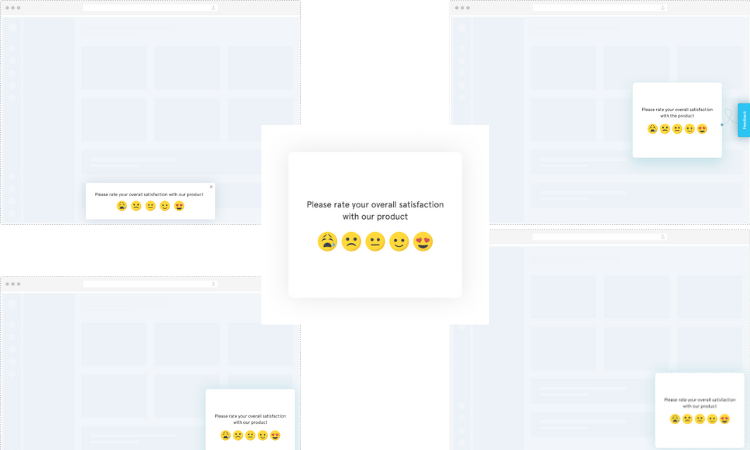Ask the most effective Product Research Survey Questions at every stage of your product development process to build a successful, customer-centric product.
In a competitive landscape where the success of product launches hangs in the balance, there's a harsh reality that haunts many businesses: a staggering 95% of product launches fail due to the lack of thorough research. It's a shocking revelation, underscoring the important role that research plays in the destiny of a product.
So, how can you ensure that your product doesn't become just another statistic?
The answer lies in leveraging the power of product research survey questions. When users offer product feedback, they provide valuable insights that can shape the trajectory of your offering. By actively seeking their opinions and experiences, you can create a product that meets user expectations and exceeds their needs. This not only boosts user satisfaction but also cultivates a loyal user base that becomes advocates for your product.
Measure Product Feedback & User Insights
With Product Feedback Surveys, understand what users need and learn ways to delight your customers.

In this blog post, we delve into the realm of product surveys, exploring their significance and providing practical guidance on crafting effective product research survey questions. Let us begin by understanding what exactly is product research survey.
Table of Content
- What is Product Research Survey?
- Product Research Survey Questions during Different Stages of Product Development
- Product Research Survey Questions across Various Touchpoints
- Common Product Research Survey Questions
- When to Conduct Product Research?
- Best Practices for Conducting Product Research Survey
- Sharing Product Research Survey
- Why Conduct Product Research?
- Conclusion
What is Product Research Survey?
A product research survey is used by businesses to gather information and insights from potential or existing users about a specific product. The survey collects feedback, opinions, and suggestions regarding the product's features, new products, or different product lifecycle stages.
A product research survey aims to gain a deeper understanding of user-led decisions and the market landscape. By researching the product, you can understand the target market's needs and preferences, identify areas for improvement, validate product ideas, and make data-driven decisions.
Since market research is a crucial part of product research, you can leverage this product market-fit survey template to find out if the product is a perfect market fit and capture user feedback.
Product Research Survey Questions during Different Stages of Product Development
The development of a product is a multi-stage process that involves careful planning, design, testing, and refinement. At each stage, a product research survey can come in handy to gather insights and make informed decisions.
Let’s dive into the product research survey questions that you can ask your users based on the stage in which your product is or if you are planning to develop a new product to create a user-centric product and optimize it as per their demand.
1. Product Research Survey Questions for Ideation
The initial stage of product development revolves around generating ideas and conceptualizing potential solutions. It involves identifying gaps in the market and aiming to create a product that solves some problem.
Say you have already found an idea on which you want to develop your product; how would you know if that aligns with your users? By carrying out product research comprising a product-market-fit survey, you can validate your idea, or if you are seeking some fresh ideas, you can leverage the survey to fetch new ideas based on user responses. Understanding user expectations early on helps shape the direction of product development and increases the likelihood of delivering a solution that meets market demand.
Let us look at some product research survey questions you can use to make an effective product in the ideation phase.
- What challenges or problems do you currently face in [specific area or industry]?
- Are there any existing solutions or products you find lacking in addressing these challenges?
- Would you be interested in a new product that aims to solve these challenges? Why or why not?
- What specific features or functionalities would you find most valuable in a product addressing these challenges?
- Are there any alternative methods or workarounds you currently use to address these challenges?
- Which other brands or products do you associate with solving similar problems?
2. Product Research Survey Questions on Screening
Once you have collected all the ideas, it is time to choose the product idea that has the highest potential for success. While developing a new product idea, a proof of concept (POC) can be helpful to check the selected idea’s feasibility with the help of your Agile development companies.
You can also conduct a product SWOT analysis to shortlist a new product idea. Product SWOT analysis questions help identify the internal and external factors that can impact the success of your product. By taking insights from your agile development team, scrum master, and product manager, you can do a detailed analysis of the idea to identify strengths and opportunities and overpower threats and weaknesses.
Here are some product research survey questions focused on screening that captures the USP, market demand, and potential barriers:
- What do you believe sets our product apart from others in the market?
- In your opinion, what unique value does our product offer that is not readily available elsewhere?
- What would be the primary reason for you to choose our product over competitors?
- Are there any specific areas where you think our product could be improved?
- How does our product's perceived value align with your expectations of the price?
- What concerns or reservations do you have regarding implementing or using our product?
- Are there any market or industry trends that could pose a risk to the viability of our product?
3. Product Research Survey Questions on Concept Development & Testing
To get your finally selected product idea evaluated by the users, it is essential that you perform concept testing. It will help you collect feedback on your idea and help you prevent new product launch failures.
Additionally, by conducting a product research survey, you can gather insights on specific features and functionalities that users find appealing or lacking in your product concept. This feedback allows you to refine and optimize the concept to align with user expectations and preferences.
Consider these questions to get a deeper insight into your product’s concept testing stage, as these will gauge the perception of the concept, value proposition, and product feature feedback:
- How would you describe your initial impression of our product concept?
- On a scale of 1 to 10, how likely are you to be interested in using or purchasing this product?
- How does this concept address your current challenges or pain points?
- Do you believe this product concept offers a unique advantage over existing alternatives?
- Are there any specific features that you believe should be prioritized or given more emphasis in developing the product?
- What aspects of the product’s features make it stand out or differentiate it from competing products
- Does this product concept have any features or functionalities that you find particularly interesting or innovative?
4. Product Research Survey Questions on Market Strategy
The next and most important stage in developing a new product idea is devising a marketing strategy that can inform your target users that you have a solution for their problems. You can leverage various market research tools available in the market that can be helpful in spreading awareness about your offering and communicating the value proposition of your product.
The most straightforward way to do this is by referring to McCarthy’s 4Ps, also known as the marketing mix. It is a framework that outlines the four key elements, namely product, price, place, and promotion, which are essential in any product marketing strategy and ensuring the success of a product.
Let us look at each of these aspects and product research survey questions based on them.
a. Product
The product is what you would offer to your users after finalizing based on the concept testing report. It includes the features, design, quality, packaging, and branding of the product. When assessing the product, you can include product survey questions such as:
- How satisfied are you with the features and functionality of the product?
- What improvements or additional features would you like to see in the product?
- How does the product's quality compare to similar products in the market?
b. Price
It refers to the amount users are willing to pay for the product. It includes pricing strategies, discounts, and perceived value. Product research survey questions related to price can include:
- How do you perceive the price of the product compared to its perceived value?
- Are you willing to pay the current price for the product? If not, what price range would you consider more reasonable?
- Are there any pricing models or options that you find more appealing for this type of product?
c. Place
It refers to the distribution channels and methods used to make the product available to customers. It includes decisions regarding the location, channels, logistics, and accessibility of the product. Product research survey questions related to place can include:
- How convenient is it for you to access and purchase the product?
- Are there any specific distribution channels or locations where you would prefer to find the product?
- Do you have any suggestions or feedback regarding the product's availability and accessibility?
d. Promotion
It refers to the marketing activities and communication strategies used to promote and create product awareness. It includes advertising, public relations, sales promotions, and digital marketing efforts. Product survey questions related to promotion can include:
- How did you first hear about the product?
- Have you seen or come across any promotional materials or advertisements for the product?
- How effective do you find the marketing and promotional efforts in conveying the value and benefits of the product?
5. Product Research Survey Questions on Product Development
Once your product idea is in place and your winning product experience strategy has been defined, it is crucial to embark on the product life-cycle development process. This process typically involves developing a prototype and Minimum Viable Product (MVP) to test and validate your product concept. Conducting a product research survey at each stage of this development process is essential to gain valuable insights into the market viability, user satisfaction, and areas for improvement of your product.
During the prototype development stage, you can conduct a product research survey to assess your prototype's initial perception and viability. This can include questions such as:
- What are your overall impressions of the prototype?
- Does the prototype accurately represent the intended functionality and design of the product?
- How would you rate the overall visual appeal of the prototype's user interface?
- Is the prototype's user interface easy to navigate and understand?
- On a scale of 1 to 10, how satisfied are you with the user interface and user experience of the prototype?
- Are there any specific improvements or modifications you would suggest for the prototype?
As you move forward to develop the MVP, conducting a product research survey becomes even more critical. This survey can focus on gathering feedback on the core features, user experience, and potential market acceptance of the MVP. Consider including the following questions:
- How well does the MVP address your needs or solve your problem?
- Are there any specific features or functionalities that are missing or could be enhanced in the MVP?
- Would you be interested in using or purchasing the MVP? Why or why not?
Additionally, you can inquire about the pricing perception, competitive differentiation, and potential barriers to adoption for the MVP. These questions may include:
- How do you perceive the value of the MVP in relation to its expected price?
- How does the MVP compare to other similar products or solutions currently available in the market?
- Are there any factors or concerns preventing you from adopting the MVP?
6. Product Research Survey Questions on Deployment
The MVP leads to the product shifting in the live environment, where users can offer their feedback on your product’s first impression. However, before your product is officially launched, you have to focus mainly on two stages of deployment: alpha and beta deployment.
While an alpha deployment product research survey can be distributed to the internal team and selected few trusted users, beta deployment product research can be shared among broader users outside the development team.
Here are some product research survey questions focused on deployment, specifically alpha deployment by developers that can also be used in a beta testing survey.
- How would you rate the overall stability and performance of the product during the alpha deployment?
- Were there any specific bugs, glitches, or issues you encountered while using the alpha version?
- Are there any specific features or functionalities that are not working as expected?
- Are there any missing features or functionalities that you believe should be included?
- Are there any performance or compatibility issues you have experienced with different devices or platforms?
- How well does the product meet your expectations based on its description and marketing materials?
7. Product Research Survey Questions on Market Entry
If your product crosses all the stages of product development and has evolved by incorporating user feedback and stakeholder insights, nothing can stop it from becoming a product-market fit. Emphasizing the USP instead of the whole product can be the driving factor for your product’s popularity, as seen in HubSpot's case.
At this stage, the product research survey question will fetch end-user feedback on the overall product. Focus on gathering insights about market acceptance, competitive positioning, and user expectations.
Here are some product research questions on the market entry that can give you real-time feedback from end-users on your product.
- What specific features or functionalities are most important to you in a product like ours?
- How satisfied are you with the pricing of our product?
- How well do you think our product addresses your needs or solves your problems?
- How likely are you to recommend our product to others?
- How did you first hear about our product?
- How effective do you find our marketing messages in conveying the value of our product?
Product Research Survey Questions across Various Touchpoints
To comprehensively understand the user experience and drive success, you must continue product research at all touchpoints. By conducting online surveys and gathering insights at each touchpoint, you can identify issues, areas for improvement, and moments of delight throughout the user journey. This holistic approach enables you to take a user-centric approach, align your product offerings with user needs, and make informed, data-driven decisions.
You can gain positive word-of-mouth referrals and foster loyalty over time by addressing customer concerns, enhancing satisfaction, and delivering an enhanced product experience. Continuous product research and improvement across all touchpoints empower you to stay attuned to customer preferences, maintain a strong brand reputation, and create products and experiences that exceed expectations.
Here are the key touchpoints where product research surveys can be most valuable.
1. Pre-Purchase
During the pre-purchase stage, your aim should be to gauge user awareness about your product, identify the sources of information that influence users, and understand their decision-making process. By asking relevant questions about customer needs and considerations, you can tailor your offerings and effectively reach your target audience, increasing the chances of conversion.
Here are some important aspects to focus on when conducting pre-purchase product research surveys:
a. Awareness and Discovery
Assess users’ awareness of your product, their sources of information, and how they discovered your brand. Ask questions about advertising effectiveness, online presence, and the impact of word-of-mouth recommendations.
- How did you first become aware of our product?
- What sources of information did you use to learn more about our product? (e.g., online search, social media, word-of-mouth)
- On a scale of 1-10, how familiar are you with our brand and product offerings?
- Have you come across any positive reviews or testimonials about our product?
b. Decision Making
Understand the factors that influence customers' purchase decisions. Inquire about their needs, preferences, and considerations. Ask about the importance of product features, pricing, reviews, and other factors that drive their decision-making process.
- What factors are most important to you when considering a purchase? (e.g., price, quality, features, brand reputation)
- How do our product features align with your needs and preferences?
- What information or details are you seeking before making a purchasing decision?
- What could potentially influence your decision to purchase our product? (e.g., discounts, product guarantees, customer reviews)
2. Purchase
Conducting product research surveys after users have purchased your product can provide insights into the ease of the purchase process, user satisfaction with pricing, and overall satisfaction with the buying experience. You can gather valuable feedback to optimize the purchase touchpoint and address any concerns or friction points through this feedback.
Consider these questions to add to your product research survey to understand the purchase experience of your users.
a. Buying Experience
Evaluate customers' satisfaction with the purchase process, including factors such as ease of navigation, checkout process, payment options, and order confirmation. Seek user feedback on any pain points or areas for improvement. Ask the right post-purchase survey questions to gauge their satisfaction in terms of the purchase experience.
- How would you rate your overall experience during the purchase process?
- Were you able to find the product you were looking for easily?
- Did you encounter any difficulties or frustrations while navigating through the purchasing steps?
- How satisfied are you with the available payment options?
- Did you receive clear and sufficient information about the product before making the purchase?
b. Pricing Reception
Gauge customers' perceptions of your product's pricing, value for money, and any pricing strategies or promotions. Assess their willingness to pay and whether they feel they received a fair deal.
- How would you rate the pricing of our product in terms of value for money?
- Did you find our pricing competitive compared to similar products in the market?
- Did you perceive any discounts or promotional offers as a positive incentive to make the purchase?
- How transparent and clear was our pricing structure?
- Did you have any concerns or reservations about the pricing of our product?
3. Post-Purchase
Product research surveys implemented post-purchase will help understand the user’s overall experience with the product. The online survey can provide insights into the product's performance, customer support and service, and opportunities for improvement. Based on the feedback, you can refine your product, enhance customer service, and retain users for a long and make them your brand advocates.
Consider these segments through the product research survey to evaluate in the post-purchase touchpoint.
a. Product Usage and Experience
Assess users’ satisfaction with the product's performance, usability, and overall experience. Ask about specific features they find valuable, any challenges faced, and suggestions for improvement.
- How frequently do you use our product?
- Are you satisfied with the performance and functionality of our product?
- Have you encountered any challenges or issues while using our product?
- How does our product meet your expectations in terms of quality and reliability?
- Would you recommend our product to others based on your usage experience?
b. Customer Support and Service
Evaluate users’ interactions with your customer support team. Inquire about response times, helpfulness, and problem resolution. Understand how satisfied they are with the level of support received.
- How would you rate your interaction with our customer support team?
- Were your inquiries or concerns addressed in a timely and satisfactory manner?
- Did our customer support team provide clear and helpful assistance?
- How would you rate the availability and accessibility of our customer support channels?
- Would you reach out to our customer support team again if you encounter any issues?
c. Product Feedback and Improvement
Encourage customers to provide feedback on their overall satisfaction with the product. Inquire about areas for improvement, new features they would like to see, and their suggestions for enhancing the product's value.
- Do you have any suggestions or ideas for improving our product?
- Is there any additional feature or functionality you would like to see in future updates?
- How would you rate the ease of providing feedback or reporting issues with our product?
- Have you participated in any user testing or beta programs for our product?
d. Repurchase Intentions and Loyalty
Assess users’ likelihood to repurchase your product and their loyalty towards your brand. Determine if they would recommend your product to others and understand the factors that drive their loyalty.
- Based on your experience with our product, are you likely to purchase from us again in the future?
- How satisfied are you with the overall value you received for the price paid?
- Would you consider purchasing additional products or services from our brand?
- On a scale of 1-10, how likely are you to recommend our product to others?
Common Product Research Survey Questions
Other than the ones discussed above, there are different categories where product research surveys be extremely helpful in understanding how users view your product and brand. Including product research survey questions on these categories can provide insights into the users’ behavior, allowing you to make data-driven decisions and optimize your product strategy.
Let's explore product research survey questions based on these common categories in detail:
1. Product Research Survey Questions on General Product Satisfaction
Understanding the overall satisfaction levels of your customers is crucial for measuring the success of your product. By including questions related to product quality, reliability, ease of use, and value for money, you can assess the level of satisfaction among your user base. This information helps you identify areas for improvement, enhance customer experience, and maintain a positive brand reputation.
- On a scale of 1 to 10, how satisfied are you with the overall quality of our product?
- How likely are you to recommend our product to others?
- What aspects of our product do you find most satisfying?
- Is there anything about our product that you find disappointing or unsatisfactory?
- How would you rate the value for money of our product?
2. Product Research Survey Questions on Brand Perception
Understanding how customers perceive your brand is crucial for building a strong brand image and reputation. By including questions about brand awareness, brand associations, brand loyalty, and perceived brand value, you can assess the overall perception of your brand. This information helps you refine your brand messaging, align marketing strategies, and develop a brand identity that resonates with your target audience.
- How familiar are you with our brand?
- How would you rate the reputation and credibility of our brand?
- Do you consider our brand to be innovative?
- How likely are you to trust our brand over competing brands?
Product Research Survey Questions on Demographic and Psychographic Analysis
Understanding your target audience's demographic and psychographic characteristics is crucial for effective product development and marketing. Product research questions related to demographics (age, gender, location, etc.) and psychographics (interests, preferences, values, etc.) can help you to segment and analyze your user base. By leveraging this information, you can tailor your product features, messaging, and marketing efforts to specific user segments, ensuring a more personalized and targeted approach.
- What is your age group?
- What is your gender?
- Which country or region are you located in?
Product Research Survey Questions on Product Lifecycle and Upgrades
Assessing the product lifecycle and understanding customers' expectations regarding upgrades and new releases is essential for long-term success. By including questions about future product enhancements, interest in upgrades, and willingness to try new versions, you can plan for future product iterations, prioritize feature development, and ensure a seamless transition for existing users.
- How interested are you in trying out new features or upgrades for our product?
- Would you be willing to pay for upgraded versions or additional features?
- How satisfied are you with our company's current product support and updates?
- Is there anything specific you would like to see improved or added in future versions of our product?
When to Conduct Product Research?
The specific timing of product research will depend on factors such as the nature of the product, market dynamics, business goals, and available resources. Let us look at the different scenarios where conducting product research can be beneficial.
- Pre-launch: Before introducing a new product to the market, conducting product research can help gather insights based on customer needs. This research can validate the concept testing, assess product-market fit, and inform product development decisions.
- During Product Development: Conducting research during product development is crucial for testing and gathering feedback on new iterations, making improvements, and assessing the effectiveness of a Minimum Viable Product (MVP) through a soft launch before a full market release.
- Post-launch: After a product has been launched, product research helps gather user feedback from those who have used or experienced the product and make changes for an enhanced product experience.
- Competitive Analysis: Product research can also be conducted to analyze and compare your company’s product with its competitors. This can help you to gain deeper knowledge about market trends, identify competitive advantages, and refine your product strategy.
- Ongoing Basis: Product research is an ongoing process. Collecting feedback and monitoring customer satisfaction regularly can help improve your products, stay relevant in the market, and meet evolving customer expectations.
Best Practices for Conducting Product Research Survey
If you want your product research to become really effective, you need to keep certain things in mind while creating your product research survey. Whether you are leveraging a product research survey template or creating from scratch, you can opt for the best practices mentioned here.
- Customize Survey based on Objective: Tailor your survey questions and approach based on the specific objective of your research. Whether you're gathering insights for a new product or seeking reviews on an existing product, ensure that the survey addresses your specific research goals and provides actionable insights for decision-making.
- Identify Target Audience: Categorize your target audience based on relevant criteria such as demographics, user behaviors, or specific user segments for targeted feedback. This allows you to gather insights from groups most likely to use or benefit from your product. If you are conducting surveys online, using best residential proxies can help you collect feedback more efficiently while maintaining privacy. For example, ISP proxies can provide fast, reliable, and secure connections, ensuring smooth data collection without interruptions.
- Use a Mix of Questions: Utilize a combination of open-ended and closed-ended questions to gather comprehensive feedback. Closed-ended questions provide structured data and allow for easier analysis, while open-ended questions encourage participants to share their thoughts, ideas, and suggestions in their own words. This provides richer qualitative insights and helps capture nuanced product feedback.
- Sequence Questions Logically: Consider logically placing the product research survey questions to personalize the survey experience using survey logic and branching. This allows for routing respondents to relevant sections based on their previous responses and ensures users only see questions that are relevant to them.
Sharing Product Research Survey
Conducting product research involves creating the survey and sharing it through survey channels that would receive the maximum response. If you have maximum users leveraging your product or application, it is best to display the product research survey in-product or app for maximum responses. Similarly, if you are getting maximum engagement on your website, it is best to embed a product research survey on the website.
Let us look at some common survey distribution channels that can get you maximum response while conducting your product research.
a. In-product/App
One effective method is to integrate the survey directly within your product or app. This allows users to provide feedback while using the product, capturing their thoughts and opinions in real-time.
You can strategically place the survey at relevant touchpoints, such as after completing a specific action or within a designated feedback section. In-product or in-app surveys provide a seamless user experience and have the advantage of capturing feedback from users who are actively engaged with your product.
b. Web Widgets
Web widgets are interactive elements that can be added to your website to engage visitors and collect feedback. These widgets can be strategically placed on your website to prompt users to participate in your product research survey. For example, a popup or slide-up surveys can be triggered after a certain amount of time or when a user tries to exit the website, grabbing their attention and encouraging survey completion.
Here are the most common web widgets that you can use to conduct product research surveys.
- Popup: A popup survey appears as a separate window overlaying the webpage, drawing the user's attention to the survey.
- Popover: A popover survey is a smaller, less intrusive overlay that appears within the webpage itself.
- Feedback Button: A feedback button is a clickable element of the website that expands into a survey form when clicked.
- Slide up: A slide-up widget is a discreet, non-intrusive panel that slides up from the bottom of the webpage.
- Bottom Bar: A bottom bar widget is a fixed element positioned at the bottom of the webpage, allowing users to access the survey easily.

c. Email
You can send targeted emails to your user base, inviting them to participate in the survey. This method is particularly useful for reaching out to a specific segment of your audience or existing users. The best part about using email surveys is users can take the product research survey at their convenience, thereby increasing the response rate. You can also personalize the email content to enhance engagement and increase the likelihood of survey completion.
Why Conduct Product Research?
Product research is vital to achieving product-led growth and sustainability. By delving into the market, understanding user needs, and gathering valuable feedback from users, you can make informed decisions that drive innovation and maximize profitability. According to Mckinsey Global Institute, by understanding your users, fetching their data, and analyzing them, you are 23 times more likely to acquire users and 6 times more likely to retain them.
Let us look at the reasons why you must conduct product research irrespective of the stage in which your product is.
- Identify Market Opportunities: Through product research, you can understand the current market landscape and user demands and uncover gaps in the market that can be capitalized upon. This information allows you to develop new marketing strategies and products that cater to unmet needs or improve upon existing solutions, giving you a competitive advantage.
- Validate New Product Ideas: Before investing significant resources into developing a new product, it is essential to validate its viability in the market. Product research helps you to assess the potential demand, acceptance, and profitability of new product ideas. By conducting surveys and performing market testing, you can gather feedback from potential users. This validation process helps mitigate the risk of launching a product that might not resonate with the target market.
- Optimize Product Features: Through surveys and usability testing, you can gather feedback on various aspects of the product, such as design, functionality, and user experience, and even end up getting product feature requests. This feedback allows you to make data-driven decisions to enhance and refine product features, resulting in higher customer satisfaction and loyalty.
- Maintain Customer Lifetime Value (CLV): Through product feedback from users, you can continuously improve your product and make it at par with user expectations. This can improve customer satisfaction and loyalty and get you a high Net Promoter Score. Satisfied and loyal customers are more likely to make repeat purchases and recommend the product to others, thereby increasing CLV.
- Evaluate User Satisfaction & Loyalty: By collecting feedback from users about their experiences with the product, you can address any issues promptly. Additionally, by measuring customer satisfaction and by performing NPS Data Analysis & Reporting, you can gauge the overall sentiment and loyalty of your user base.
Conclusion
Product research surveys play a vital role in every stage of the product development lifecycle. By leveraging well-designed product research surveys, you can capture your target users' feedback and make informed decisions to create a successful product. From the ideation phase to market entry, product research surveys help in identifying market opportunities, validating ideas, and optimizing features.
For creating Product Research Surveys, it is important that you leverage a good Product Feedback tool that helps you not only collect and analyze feedback but also measure trends, take action, and close the feedback loop to enhance user satisfaction and loyalty.
Zonka Feedback is one of the most effective Product Feedback tools that you can use to create effective surveys, share them with your users via multiple channels, and collect feedback. With its powerful reporting and dashboard capabilities, it also enables you to analyze feedback and trends and take action on feedback to improve your product and enhance user experience.
You can start using Zonka Feedback and see how it works for you. Book your demo.





.jpg)




.png)

.jpg)